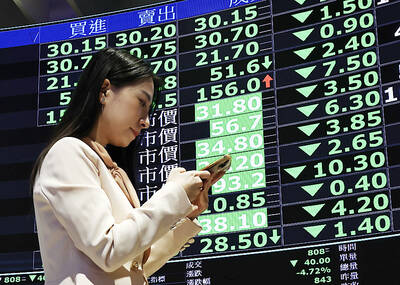The nation’s green bond issuance is expected to set a record of NT$56.6 billion (US$1.97 billion) this year, up 12 percent from NT$50.2 billion last year, as companies took advantage of lower interest rates to raise funds, Taipei Exchange (TPEX) data showed.
Taiwan Semiconductor Manufacturing Co (TSMC, 台積電) yesterday issued NT$12 billion of green bonds in three tranches, the first for the world’s largest contract chipmaker, boosting the nation’s cumulative green bond issuance to NT$53.6 billion this year to date, the data showed.
TSMC has said it would use the proceeds to cover its capital expenditure for green buildings and other projects aimed at environmental improvement.

Photo: Hung Yu-fang, Taipei Times
The coupon rates of TSMC’s green bonds hover between 0.4 and 0.48 percent, lower than the rates of 0.5 to 0.67 percent for the corporate bonds it issued earlier this year, TPEX data showed.
TSMC’s green bonds were the third-largest issuance so far this year, following Orsted Wind Power TW Holding A/S’ green bonds valued at NT$15 billion and Taiwan Power Corp’s (Taipower, 台電) green bonds valued at NT$12.8 billion, the data showed.
HSBC Bank Taiwan Ltd (匯豐台灣商銀) yesterday said it would issue NT$3 billion of five-year green bonds with a coupon rate of 0.4 percent on the TPEX on Dec. 25, adding that the bonds would rank first in terms of size among all green bonds issued by financial firms.
The bank’s issuance would raise the nation’s cumulative green bond issuance to NT$56.6 billion, which would be a new record for a single year, the data showed.
HSBC Taiwan, which has been focusing on financing offshore wind projects, would use the proceeds to finance the projects and other green loans, the bank’s head of global markets Ruby Ho (何汝平) told the Taipei Times by telephone yesterday.
Although the bank could also use deposits as financial resources, issuing long-term bonds with fixed rates could help keep the bank’s capital ratio and liquidity ratio at better levels, Ho said.
“Green bond issuance has been hot this year, non only in Taiwan, and the primary reason is lower interest rates,” Ho said, adding that the financial instrument is expected to remain popular next year, as the local regulator has been promoting green financing.
Asked if she expects small and medium-sized enterprises (SMEs) to increasingly issue green bonds, Ho said it would depend whether they have specific green projects, as the proceeds from green bonds can only be spent on eligible projects.
Furthermore, as companies need to have a third-party organization check their green projects, which would be a costly process, SMEs might consider issuing green bonds instead of regular corporate bonds when their demand for funds are high enough, Ho said.

TARIFFS: The global ‘panic atmosphere remains strong,’ and foreign investors have continued to sell their holdings since the start of the year, the Ministry of Finance said The government yesterday authorized the activation of its NT$500 billion (US$15.15 billion) National Stabilization Fund (NSF) to prop up the local stock market after two days of sharp falls in reaction to US President Donald Trump’s new import tariffs. The Ministry of Finance said in a statement after the market close that the steering committee of the fund had been given the go-ahead to intervene in the market to bolster Taiwanese shares in a time of crisis. The fund has been authorized to use its assets “to carry out market stabilization tasks as appropriate to maintain the stability of Taiwan’s

STEEP DECLINE: Yesterday’s drop was the third-steepest in its history, the steepest being Monday’s drop in the wake of the tariff announcement on Wednesday last week Taiwanese stocks continued their heavy sell-off yesterday, as concerns over US tariffs and unwinding of leveraged bets weighed on the market. The benchmark TAIEX plunged 1,068.19 points, or 5.79 percent, to 17,391.76, notching the biggest drop among Asian peers as it hit a 15-month low. The decline came even after the government on late Tuesday authorized the NT$500 billion (US$15.2 billion) National Stabilization Fund (國安基金) to step in to buoy the market amid investors’ worries over tariffs imposed by US President Donald Trump. Yesterday’s decline was the third-steepest in its history, trailing only the declines of 2,065.87 points on Monday and

TARIFF CONCERNS: The chipmaker cited global uncertainty from US tariffs and a weakening economic outlook, but said its Singapore expansion remains on track Vanguard International Semiconductor Corp (世界先進), a foundry service provider specializing in producing power management and display driver chips, yesterday withdrew its full-year revenue projection of moderate growth for this year, as escalating US tariff tensions raised uncertainty and concern about a potential economic recession. The Hsinchu-based chipmaker in February said revenues this year would grow mildly from last year based on improving supply chain inventory levels and market demand. At the time, it also anticipated gradual quarter revenue growth. However, the US’ sweeping tariff policy has upended the industry’s supply chains and weakened economic prospects for the world economy, it said. “Now

Six years ago, LVMH’s billionaire CEO Bernard Arnault and US President Donald Trump cut the blue ribbon on a factory in rural Texas that would make designer handbags for Louis Vuitton, one of the world’s best-known luxury brands. However, since the high-profile opening, the factory has faced a host of problems limiting production, 11 former Louis Vuitton employees said. The site has consistently ranked among the worst-performing for Louis Vuitton globally, “significantly” underperforming other facilities, said three former Louis Vuitton workers and a senior industry source, who cited internal rankings shared with staff. The plant’s problems — which have not